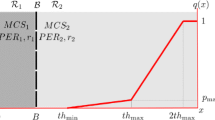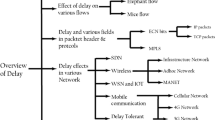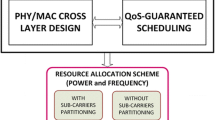Abstract
A cross layer approach based on queuing and adaptive modulation for MIMO systems has been presented. To realize the system, an adaptive modulation scheme using MIMO systems combined with finite-length queuing at the data link layer has been designed. A finite state Markov chain for MIMO channels has been constructed to persue the queuing analysis. The packet loss rate, the average throughput, and the average spectral efficiency have been computed. Furthermore, the packet error rate for adaptive modulation to minimize the packet loss rate and maximize the average throughput is extracted. The obtained results present the advantages of using the proposed cross layer architecture.
Similar content being viewed by others
References
Goldsmith, A. J., & Chua, S. G. (1997). Variable-rate variable-power MQAM for fading channels. IEEE Transactions on Communication, 45(10), 1218–1230.
Mohammadi, A., & Kumar, S. (1997). Characterization of effective bandwidth as a metric of quality of service for wired and wireless ATM networks. Proceedings of IEEE ICC, 2, 1019–1024.
Mohammadi, A., & Kumar, S. (2004). Characterization of adaptive modulators in fixed wireless ATM networks. Journal of Communications and Networks, 6(2), 123–132.
Liu, Q., Zhou, S., & Giannakis, G. B. (2005). Queuing with adaptive modulation and coding over wireless links: cross-layer analysis and design. IEEE Transactions on Communications, 4(3).
Liu, Q., Zhou, S., & Giannakis, G. B. (2006). Cross-layer modelling of adaptive wireless link for QoS support in heterogeneous wired-wireless networks. Wireless Networks, 12, 427–437.
Paulraj, A., Nabar, R., & Gore, D. (2003). Introduction to space-time wireless communications (1st edn.). Cambridge: Cambridge University Press.
Telatar, E. (1995) Capacity of multi-antenna Gaussian channels (Technical Report). AT&T Bell Labs, June 1995.
Gershman, A. B., & Sidiropoulos, N. D. (2005). Space-time processing for MIMO communications. New York: Wiley.
Zhou, Z., Vucetic, B., Dohler, M., & Li, Y. (2005). MIMO systems with adaptive modulation. IEEE Transactions on Vehicular Technology, 54(5).
Doufexi, A., Armour, S., Butler, M., Nix, A., Bull, D., McGeehan, J., & Karlsson, P. (2002). A comparison of the HIPERLAN/2 and IEEE 802.11a wireless LAN standards. IEEE Communications Magazine, 40(5), 172–180.
Edalman, A. (1989). Eigenvalues and condition numbers of random matrices. MIT University PhD dissertation, Department of Mathematics.
Wenestrom, M. (2002) On MIMO systems and adaptive arrays for wireless communication: analysis and practical issues. Uppsala University PhD dissertation.
Jafari, A., & Mohammadi, A. (2007) An adaptive modulation scheme based on packet error rate for MIMO systems. In Proceedings of IEEE WRECOM, Oct. 2007.
Wang, H. S., & Moayeri, N. (1995). Finite-state Markov channel- a useful model for radio communication channels. IEEE Transactions on Vehicular Technology, 44(1), 163–171.
Zhang, Q., & Kasaam, S. A. (1999). Finite state Markov model for Rayleigh fading channels. IEEE Transactions on Communication, 47(11), 1688–1692.
Razavilar, J., Liu, K. J. R., & Marcus, S. I. (2002). Jointly optimised bit-rate/delay control policy for wireless packet networks with fading channels. IEEE Transactions on Communication, 50(3), 484–494.
Yacoub, M. D., Vargas Bautista, J. E., & de Guedes, L. G. R. (1999). On higher order statistics of the Nakagami-m distribution. IEEE Transactions on Vehicular Technology, 48(3), 790–794.
Souza, R. D., Garcia-Frias, J., & Haimovich, A. M. (2004) Using hidden Markov models to improve performance of space-time codes in MIMO flat fast-fading channels. In Proceeding of IEEE vehicular technology (Vol. 3, pp. 1305–1309), May 2004.
Bertsekas, D., & Gallager, R. (1992). Data networks (2nd edn.). Upper Saddle River: Prentice-Hall.
Author information
Authors and Affiliations
Corresponding author
Rights and permissions
About this article
Cite this article
Jafari, A., Mohammadi, A. A cross layer approach based on queuing and adaptive modulation for MIMO systems. Telecommun Syst 42, 85–96 (2009). https://doi.org/10.1007/s11235-009-9172-y
Published:
Issue Date:
DOI: https://doi.org/10.1007/s11235-009-9172-y




